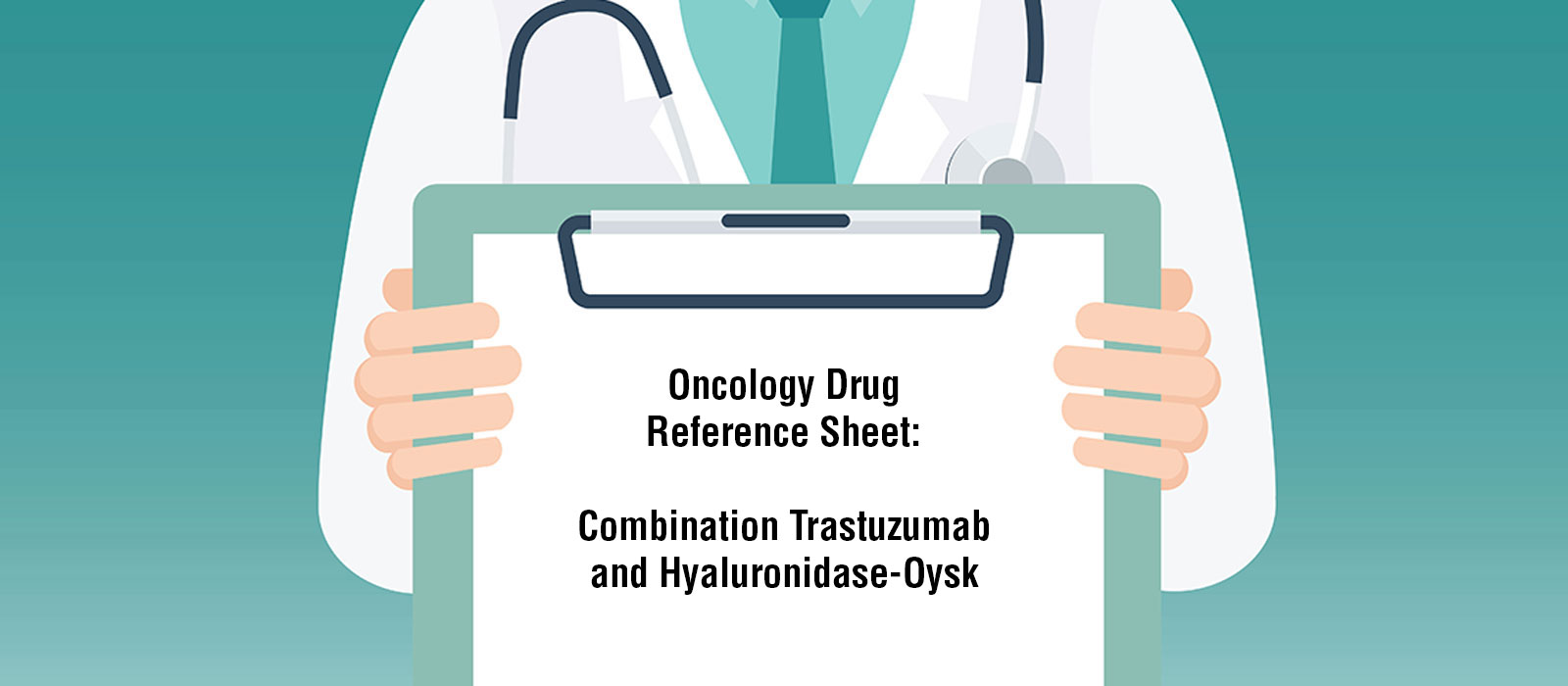A new product that combines trastuzumab and hyaluronidase (Herceptin Hylecta™) received U.S. Food and Drug Administration (FDA) approval in February 2019 for the treatment of HER2-overexpressing breast cancer. The approval was based on the results of two randomized trials: HannaH and SafeHER.
Category/Class
The biologic product is a combination of the HER2/neu receptor antagonist (trastuzumab) and endoglycosidase (hyaluronidase). Because it is a biologic agent, the nonproprietary name includes a four-letter suffix based on FDA naming conventions.
Indication
The combination product is indicated for adjuvant treatment of adults with HER2-overexpressing, node positive or node negative (estrogen-receptor and progesterone-receptor negative or with one high-risk feature) breast cancer in the following situations:
- In combination with doxorubicin, cyclophosphamide, and a taxane (either paclitaxel or docetaxel)
- In combination with docetaxel and carboplatin
- As a single agent following multimodality anthracycline-based therapy
It is also indicated for adults with metastatic, HER2-overexpressing breast cancer in these situations:
- In combination with paclitaxel as first line treatment
- As a single agent in individuals who have received one or more previous chemotherapy regimens for metastatic disease
Dosing
Dosing for the combination product is 600 mg/10,000 units (600 mg trastuzumab and 10,000 units hyaluronidase) administered subcutaneously. No loading dose is required. No dose adjustments are recommended for patient body weight.
Note: The dosing is different than IV trastuzumab, and the combination product should not be administered via IV. It should not be substituted for the immunoconjugate product ado-trastuzumab emtansine.
Administration
The combination product is given every three weeks as a ready-to-use solution that is administered subcutaneously over two to five minutes. The solution does not need to be diluted. FDA recommended attaching the hypodermic injection needle to the syringe immediately prior to administering the dose, then adjusting the volume to 5 ml.
Alternate injection sites between the left and right thigh. Do not administer into areas that are red, bruised, tender, or hard. Avoid areas with scarring or moles. Administer new injections 2.5 cm from previous injection site on healthy skin.
Adverse Reactions
The following black box warnings are included with the FDA labeling for combination trastuzumab and hyaluronidase-oysk:
- Subclinical and clinical cardiac failure can occur. Patients receiving the combination product with an anthracycline have the highest incidence of symptomatic myocardial dysfunction.
- Serious and fatal pulmonary toxicity can occur, often during or within 24 hours of administration.
- Exposure to the combination product during pregnancy can result in oligohydramnios, pulmonary hypoplasia, skeletal abnormalities, and neonatal death.
Other warnings and precautions include:
- Hypersensitivity and administration-related reactions, including anaphylaxis. Monitor patients for systemic hypersensitivity reactions, especially during the first administration.
- Other toxicities (≥ 10%) include fatigue, arthralgias, diarrhea, injection site reactions, upper respiratory tract infection, rash, myalgia, nausea, headache, edema, flushing, pyrexia, cough, insomnia, fever, exacerbation of chemotherapy-induced neutropenia, and pain in extremities.
Nursing Considerations
- HER2 protein overexpression and HER2 gene amplification should be assessed using FDA-approved tests.
- Because of the risk of drug-induced cardiomyopathy, all patients’ left ventricular function (LVEF) should be evaluated via echocardiogram or MUGA scan prior to initiation and intermittently during treatment. Per the package labeling, withhold treatment for a 16% decrease or higher in LVEF from baseline or an LVEF value below institutional limits of normal in combination with a 10% absolute decrease or higher from baseline LVEF values.
- Pulmonary toxicity may develop during or within the 24 hours following administration; discontinue administration immediately if patients develop signs of anaphylaxis, angioedema, or acute respiratory distress syndrome.
- Store prepared syringes at room temperature for up to four hours; do not shake.
- Verify pregnancy status of females of reproductive age prior to starting therapy.
- Do not administer the product via IV, and do not substitute for ado-trastuzumab emtansine.
Drug-Drug and Drug-Food Interactions
Patients receiving anthracycline therapy (e.g., doxorubicin, epirubicin) after stopping combination trastuzumab and hyaluronidase-oysk may be at increased risk for cardiac dysfunction because of the long elimination period; package labeling recommends that anthracycline-based therapy be avoided for seven months after stopping the combination product.
Patient Education
Advise patients of the potential embryo-fetal risk and the need for effective contraception while on therapy and for seven months following the last dose. Report any new onset or worsening shortness of breath, cough, edema, palpitations, weight gain of more than five pounds in 24 hours, dizziness, or loss of consciousness. Discuss the potential for pulmonary toxicity, particularly in the 24 hours following administration.
Safe Handling
Because of the known embryo-fetal toxicity following exposure to combination trastuzumab and hyaluronidase-oysk, nurses should exercise hazardous drug precautions when handling.
Patient Assistance
The manufacturer has a patient assistance tool online. Visit genentech-access.com/hcp.html for more information or call 866-422-2377.






